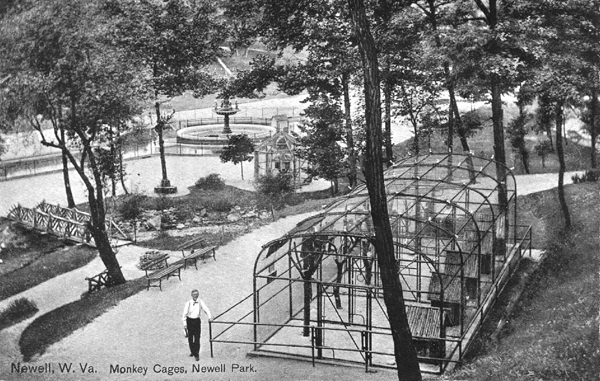Rise and Fall of the Newell Park Zoo
By Bob Barnett

The Newell Park Zoo in Newell, Hancock County, operated from 1906 until 1912. This postcard view shows the zoo during its heyday, with monkey cages in the foreground.
Courtesy of David Jester.
May 23, 1909, was to be the biggest day in the short history of the Newell Park Zoo. The zoo, located in Laurel Hollow in Newell, Hancock County, had opened for its fourth season the previous Sunday, attracting 2,000 people. Many more visitors were expected this Sunday : so many that the streetcar line put on extra cars to handle the huge crowd that was predicted.
The Newell Park Zoo, with its cages of seals, monkeys, geese, porcupines, deer, and raccoons, and the adjacent Laurel Hollow picnic grounds were immaculate. The flower beds were in full bloom, planted, trimmed, and manicured by a crew from the Homer Laughlin China Company, which owned the zoo (under the auspices of its subsidiary the North American Manufacturing Company). Homer Laughlin was the largest employer in the town and had been the driving force in building the town less than five years before. [See "The Homer Laughlin China Company," by Jack Welch; Spring 1985.]
The major draw on that warm spring day was the premier of the most impressive animal attraction ever housed in northern West Virginia. The Newell Park Zoo had purchased two polar bears to live at the zoo in a cage especially built for them.
George Washington Clarke, a vice president of Homer Laughlin and its leading salesman, was a strong advocate for developing a free recreational program in Newell. Artistic, courteous, and urbane, he was the company's leading salesman and a legend in the pottery business. Clarke felt that an attractive opportunity for recreation would draw workers to the new town of Newell and help keep the work force contented at a time when the company was expanding and workers were scarce. He believed that recreation should be provided for free, unlike the nearby Rock Springs Park in Chester, which was a full-blown, for profit, amusement park with paid rides, restaurants, and shows. [See "Rock Springs Park: A Panhandle Playground," by Susan M. Weaver; Winter 1985.]
Clarke took an active role in the development of the park. In what little spare time that he had, he served as the superintendent of Laurel Hollow and the Newell Park Zoo. Eventually, the Newell Park Zoo became his obsession.
Laurel Hollow was a beautiful valley about a -mile wide, extending south from the Ohio River for 3/4 of a mile, along both sides of the Sixth Street Hill Creek. The valley was attractive, with lush grass, abundant wildflowers, and ancient birch, oak, and beech trees shading rich bottomland.
As work progressed on the Homer Laughlin pottery, work also began on Laurel Hollow and the Newell Park Zoo. George Clarke talked the company into pouring money into the endeavor. In 1906, a series of wide pathways was laid. An artificial lake was created, for boating and swimming, by building a dam at the end of the valley near the Ohio River.
The zoo began to take shape, as well, as two seals, weighing 120 pounds each, were placed in the seal pool. Very quickly four Virginia deer, raccoons, and beavers were added. In addition, a flock of exotic birds, including pelicans, demoiselle cranes, and Mandarin ducks were purchased for the lake. On July 4, a herd of burros arrived to provide rides for children.
You can read the rest of this article in this issue of Goldenseal, available in bookstores, libraries or direct from Goldenseal.